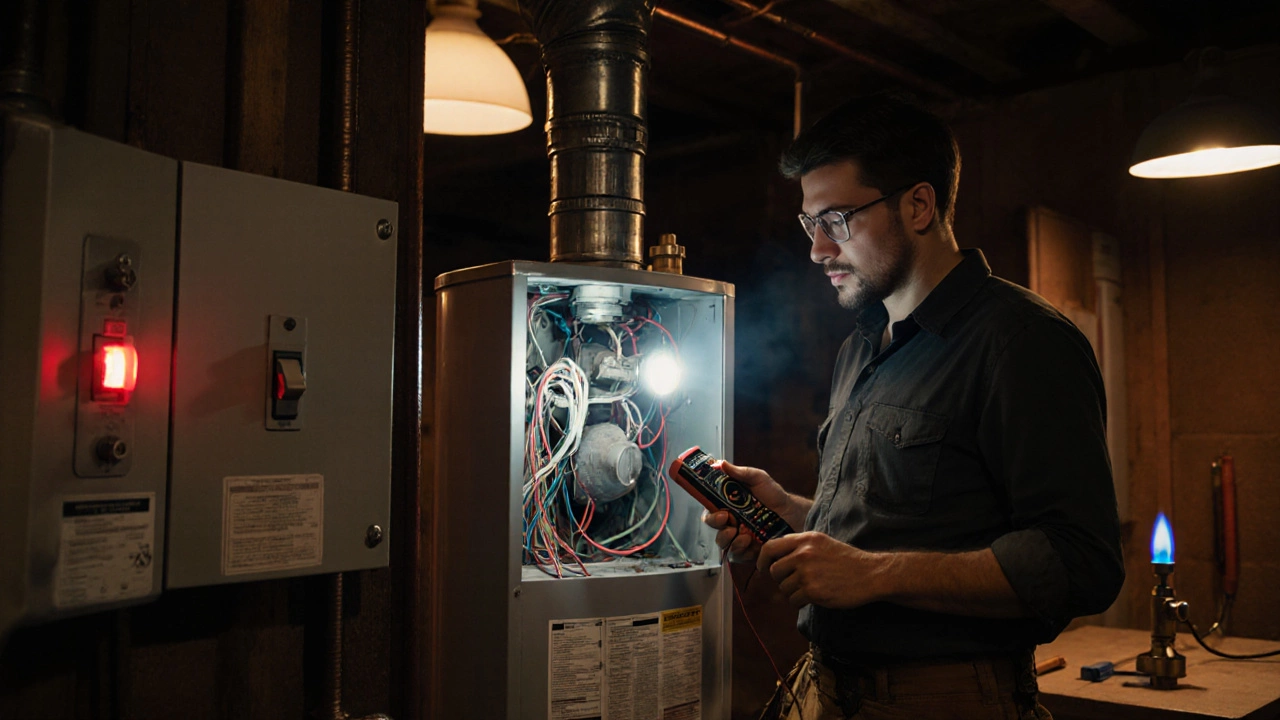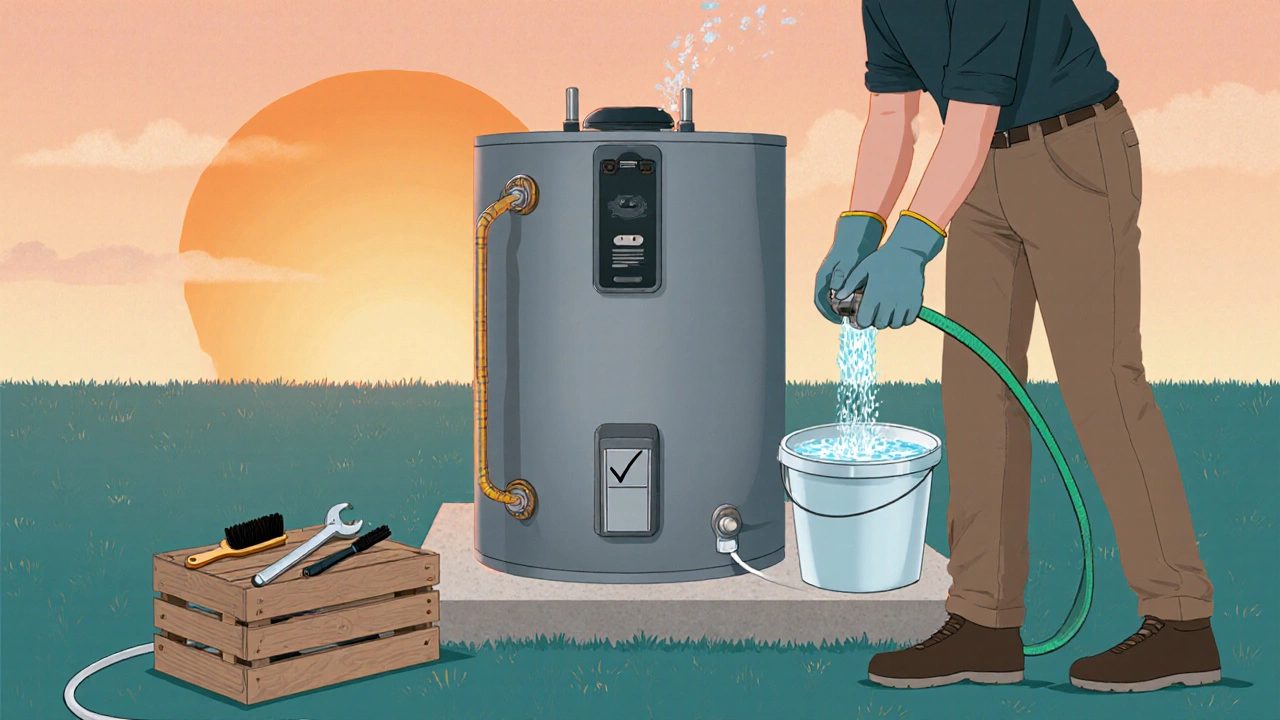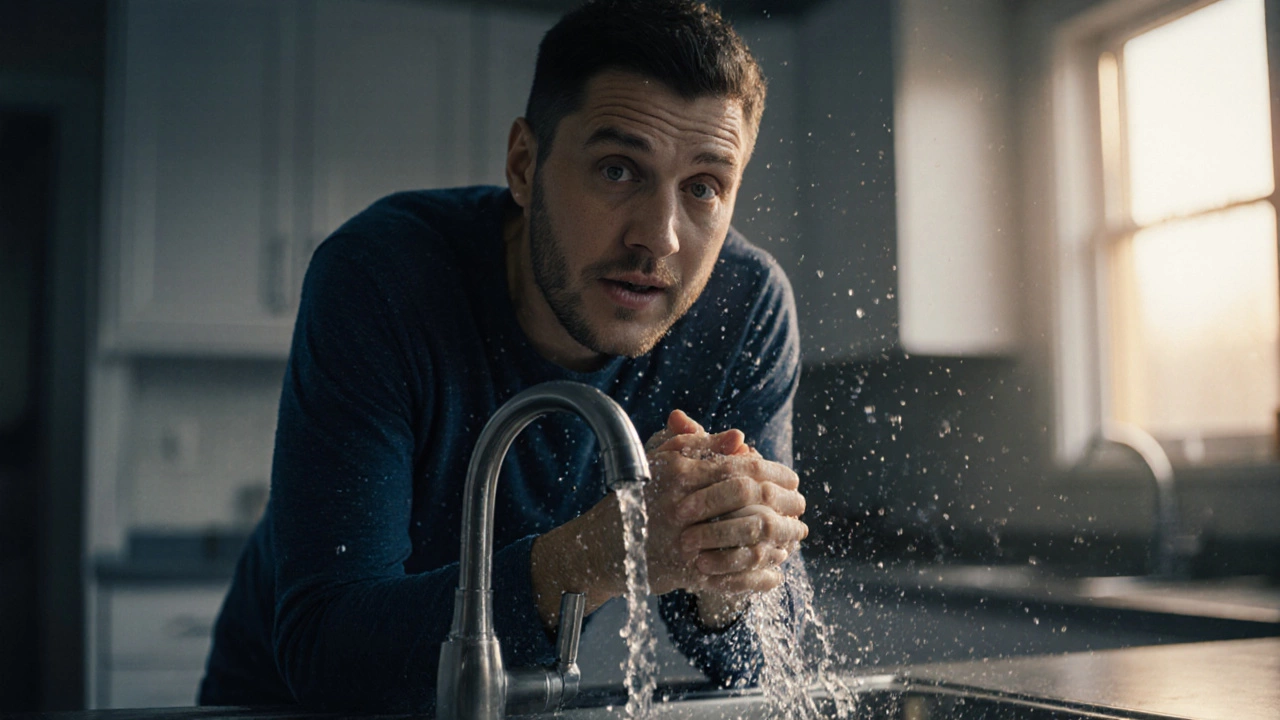Hot Water Heater Troubleshooter
What's your issue?
Select all symptoms you're experiencing to get targeted solutions.
Key Takeaways
- Most sudden failures stem from power, gas, or thermostat issues.
- Safety checks (gas leak, scalding risk) come first before any DIY work.
- Basic diagnostics can pinpoint a bad heating element, clogged pilot light, or tripped breaker.
- Regular flushing removes sediment that often triggers failure.
- Call a licensed plumber if you spot gas smells, leaking pressure‑relief valves, or complex electrical faults.
When your Hot Water Heater is a household appliance that heats water for showers, dishes, and heating systems suddenly stops delivering hot water, the first reaction is usually panic. You’re left shivering, the dishes are piling up, and the morning routine stalls. Before you start ripping out panels, it helps to know why the heater quit and what you can safely check yourself.
Why a Hot Water Heater Might Suddenly Stop
There are three broad reasons a heater goes dark: loss of power, loss of fuel, or a control malfunction. Each group has a handful of common culprits that you can usually spot with a flashlight and a multimeter.
- Power loss - A tripped Circuit Breaker the electrical switch in your breaker panel that protects circuits from overload or a blown Electrical Fuse a safety device that melts when current exceeds safe limits cuts electricity to an electric heater.
- Fuel loss - For gas models, a faulty Gas Valve the component that controls gas flow to the burner or a dead Pilot Light the small flame that ignites the main burner stops heating.
- Control issues - A broken Thermostat the sensor that tells the heater when to turn on or a failed Heating Element the metal coil that converts electricity into heat can leave the water cold.
Step‑by‑Step Diagnosis
- Check the power source. Open the breaker panel and look for a tripped breaker (it will be in the “off” position). Flip it fully to “on" and see if the heater powers up. If the breaker trips again, you likely have a short or an overload - stop here and call a electrician.
- Test the fuse. If your model uses a fuse, remove the cover and inspect it. A broken filament or a darkened glass means it’s blown. Replace with the same amperage rating.
- Inspect the gas supply. For gas heaters, ensure the gas valve is open (handle parallel to the pipe). Then look at the pilot light - it should burn blue with a steady flame. If it’s out, try relighting according to the manufacturer’s instructions. If it won’t stay lit, the thermocouple may be dirty or failed.
- Measure the thermostat setting. Use a multimeter set to resistance (ohms). Remove the thermostat housing and check the resistance at the “high” setting; it should match the spec in the manual (often around 10 kΩ). A reading outside that range indicates a bad thermostat.
- Test the heating element. With power off, disconnect the element’s wires and measure continuity. A healthy element shows a low resistance (15-30 Ω for most 4500‑W elements). Infinite resistance means the element is broken and needs replacement.
- Look for safety valve leaks. The Pressure Relief Valve a safety device that releases pressure if it gets too high is a tell‑tale sign of internal problems. If you see water dripping from the discharge pipe, the valve may have opened because of overheating or excess pressure.

Common Culprits and How to Fix Them
Below is a quick cheat‑sheet of what usually goes wrong and the simplest fix you can try.
| Symptom | Most Likely Cause | Quick Fix |
|---|---|---|
| No hot water at all | Tripped Circuit Breaker or blown Fuse | Reset breaker or replace fuse |
| Warm water only | Thermostat set too low or failing | Raise thermostat, test/replace if needed |
| Loud popping noises | Sediment buildup on Heating Element | Flush tank (see maintenance checklist) |
| Water leaking from top | Faulty Pressure Relief Valve | Replace valve, check pressure settings |
| Heater won’t ignite (gas) | Dead Pilot Light or Bad Thermocouple | Relight pilot, clean/replace thermocouple |
| Intermittent heating | Loose wiring or failing Heating Element | Inspect connections, tighten or replace element |
| Smell of gas | Gas leak at valve or connection | Turn off gas, ventilate, call a licensed plumber |
1. Tripped Circuit Breaker or Blown Fuse
Electric heaters draw a lot of current. If another high‑wattage appliance runs on the same circuit, the breaker can trip. After resetting, spread the load across separate circuits.
2. Faulty Thermostat
A stuck thermostat may think the water is already hot. If you can’t adjust the temperature knob, the internal sensor is likely dead. Replacing a thermostat costs under $30 and usually takes 15 minutes.
3. Bad Heating Element
Elements corrode over time, especially in hard‑water areas. When the element shorts, it can trip the breaker or simply stop heating. Swapping the element is a DIY job for most homeowners - just remember to empty the tank first.
4. Clogged Pilot Light or Thermocouple
Dust or debris can drown the pilot flame. Turn off the gas, clean the pilot assembly with a fine brush, and relight. If the flame still won’t stay lit, the thermocouple (the metal rod that senses heat) may need replacement.
5. Pressure Relief Valve (PRV) Issues
If the tank overheats, the PRV releases water to prevent an explosion. A leaky PRV often means the heater is running too hot because the thermostat can’t regulate temperature. Replace the valve and verify the temperature setting (usually 120 °F/49 °C).
Safety First: What Not to Do
- Never ignore a gas smell. Shut off the gas supply and ventilate the area.
- Don’t attempt to replace internal gas components unless you’re certified.
- Avoid pouring cold water on a hot element - it can cause cracking.
- Never work on a heater that’s still connected to power or gas.
- Never bypass safety devices like the PRV or temperature limit switches.

When to Call a Professional
If you encounter any of the following, it’s time to dial a licensed plumber or electrician:
- Persistent gas odor or suspected leak.
- Repeated tripping of the circuit breaker after you’ve checked connections.
- Corroded or leaking tank walls - that usually means the whole unit needs replacement.
- Complex electrical diagnostics beyond the thermostat and fuse (e.g., wiring issues in the main panel).
- Any situation where you’re unsure about turning off gas or electricity.
Preventive Maintenance Checklist
Doing a little upkeep each year can keep your heater humming for a decade. Check these items once a year, preferably before winter.
- Flush the tank. Shut off water and power/gas, connect a garden hose to the drain valve, and let the water run until it’s clear. This removes sediment that insulates the heating element.
- Inspect the anode rod. The rod (usually magnesium or aluminum) attracts corrosion. If it’s more than 50 % consumed, replace it.
- Test the PRV. Lift the lever briefly; water should flow out. If it doesn’t, replace the valve.
- Check the temperature setting. Set it to 120 °F (49 °C) for safety and energy efficiency.
- Examine venting (gas models). Make sure the exhaust pipe is clear of debris and properly sealed.
- Look for leaks. Tighten connections, replace worn gaskets, and watch for moisture around the base.
Quick FAQ
Why does my hot water heater make a banging sound?
Banging, often called "kettling," is caused by sediment build‑up on the heating element or burner. The layer of mineral deposits overheats and expands, creating a loud thump each time the heater cycles. Flushing the tank removes the sediment and stops the noise.
Can I replace a heating element myself?
Yes, if you turn off the power, drain the tank, and disconnect the element wires. Most elements are secured with two bolts and a simple twist‑off connector. Make sure the replacement matches the voltage (120 V or 240 V) and wattage of the original.
What does a constantly running pilot light mean?
A pilot that stays lit all the time usually indicates a stuck thermocouple or a gas valve that never fully shuts off. It can waste fuel and pose a safety risk. Inspect the thermocouple for carbon buildup and replace it if it’s corroded.
How often should I flush my water heater?
At least once a year in areas with hard water; every six months if you have very high mineral content. Regular flushing prevents sediment from coating the heating element and extending the heater’s lifespan.
Is it safe to use a heater with a leaking pressure relief valve?
No. A leaking PRV means the tank is over‑pressurizing, which can lead to a rupture. Turn off power or gas, shut the water supply, and replace the valve before using the heater again.
Understanding why a hot water heater suddenly quits helps you avoid panic, stay safe, and decide whether a simple DIY fix will do or a pro is required. Keep this guide handy, run the checklist each year, and you’ll enjoy steady hot water without surprise outages.

